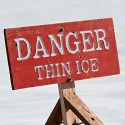Hikers Should Temporarily Avoid High Elevation Trails in the Adirondacks
 With the start of a new season of outdoor hiking and recreation, the New York State Department of Environmental Conservation (DEC) urges hikers to be cautious and postpone hikes on trails above 3,000 feet until early June when muddy trail conditions are expected to improve.
With the start of a new season of outdoor hiking and recreation, the New York State Department of Environmental Conservation (DEC) urges hikers to be cautious and postpone hikes on trails above 3,000 feet until early June when muddy trail conditions are expected to improve.
Trails and vegetation in the higher elevations are most vulnerable at this time of year when melting snow saturates thin soils found on the steep slopes of the mountains and much of the vegetation growing in high elevations is surviving on the edge of existence. Hikers can cause severe erosion of trails and significant damage to vegetation.
DEC urges hikers to avoid hiking on high elevation trails during mud season. Specifically, all trails above 3,000 feet in the Dix, Giant and High Peaks Wildernesses but also any high elevation trails on steep slopes throughout the Adirondacks.
Hikers are also more likely to slip and injure themselves on steep, wet and muddy trails.
On the lower elevation trails, snows melt sooner, soils are thicker and dry more quickly, slopes are not as steep and vegetation is less sensitive to damage from hikers. Even lower elevation muddy trails are less susceptible to erosion.
Hikers are encouraged to wear waterproof footwear and gaiters and to hike through, not around wet and muddy portions of trail to avoid widening the trails or creating “herd paths” around those areas.
DEC asks hikers to avoid the following trails:
- High Peaks Wilderness Area – all trails above 3,000 feet; where wet, muddy, snow conditions still prevail, specifically: Algonquin, Colden, Feldspar, Gothics, Indian Pass, Lake Arnold Cross-Over, Marcy, Marcy Dam – Avalanche – Lake Colden which is extremely wet, Phelps Trail above John Brook Lodge, Range Trail, Skylight, Wright and all “trail-less” peaks.
- Dix Mountain Wilderness Area – all trails above Elk Lake and Round Pond
- Giant Mountain Wilderness Area – all trails above Giant’s Washbowl, “the Cobbles,” and Owls Head.
DEC suggests the following alternative trails for hiking, subject to weather conditions:
- Debar Mt. Wild Forest:
- Azure Mountain
- Giant Mt. Wilderness:
- Giant’s Washbowl
- Roaring Brook Falls
- High Peaks Wilderness:
- Ampersand Mountain
- Cascade Mountain
- Porter Mountain from Cascade Mountain (avoid all other approaches)
- Big Slide
- The Brothers
- Hurricane Mountain Wilderness
- The Crows
- McKenzie Mt. Wilderness:
- Baker Mountain
- Haystack Mountain
- Pharaoh Lake Wilderness Area:
- Pharaoh Mountain
- Saranac Lakes Wild Forest:
- Panther Mountain
- Scarface Mountain
Hikers who wait for drier conditions will protect natural resources and trails. Also, the trails will be in better condition later in the season, making for a safer and more enjoyable hike.
DEC’s website contains additional information on :Adirondack Trail Information or contact the DEC Forest Rangers at (518) 897-1300.

 Tuesday’s rain and warm temperature has raised the levels of waters in streams and drainages throughout the High Peaks. Crossings may be treacherous if not impossible.
Tuesday’s rain and warm temperature has raised the levels of waters in streams and drainages throughout the High Peaks. Crossings may be treacherous if not impossible.





